Defining the Project Activities
The purpose of this process is to identify the specific tasks needed to be done in order to produce the project's deliverables. This needs to be done in sufficient detail to estimate what resources and time will be required to complete them. The main inputs are the scope baseline consisting of the approved project scope statement, the work breakdown structure, and the WBS dictionary.
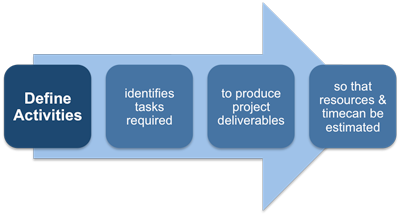 |
This process uses decomposition to take the work packages identified in the WBS, which are nouns, and to identify the activities (which are verbs) required in order to complete them. It is essentially the bridge between the planning involved in scope management, and the planning involved in time or schedule management.
The scope baseline is a component of the project plan. It is made up of:
• The scope statement, which includes the products scope description of the project deliverables and defines the product user acceptance criteria.
• The work breakdown structure, which defines each deliverable and the decomposition of the deliverable into work packages.
• The WBS dictionary, which contains a detailed description of work and technical documentation for each WBS element.
The scope baseline is used as a starting point to breakdown the documented deliverables, as well as a guide to assure that the entire scope of the project is covered, but that the activities do not extend beyond the agreed boundaries.
It is described in the eBook 'Managing the Project Scope' which can be downloaded free from this website and comprises three things-the work breakdown structure, WBS dictionary and the project scope statement. There are three interrelated techniques that can be used in this process.
In order to produce the activity list it is necessary to examine each work package and break it down into individual work schedule activities. As the name suggests the activity list, is a list of all the activities that must be performed within the project and each one should be linked back to just one work package (although each work package may have several activities within it).
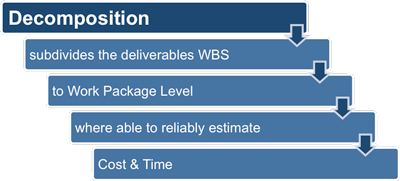 |
The work package is the lowest level of the WBS is achieved when the work can be accurately estimated (both cost and duration) and can be managed by one individual. The key word here is 'managed', although the work package can be managed by one person, the actual work within the work package may be completed by several people.
For example, One individual could manage work package 'Select and Appoint Contractor'. However, the work package could be decomposed into the following activities each of which could be undertaken by a different person:
1. Specify Task Requirements
2 Identify Potential Contractors
3. Send Invitation to Tender
4. Review Tenders
5. Interview Contractors
6. Choose Contractor
7. Check References
8. Agree Contract Terms
9. Appoint Contractor
Each activity must be complete and accurate, because it will be used to develop the project schedule. An activity is typically described using a noun and verbs such as 'Specify Task Requirements'.
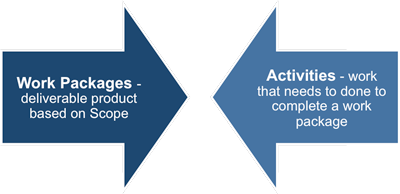 |
As you can see, when the work packages are decomposed into activities in this way the result is to create an activity list, which can then be used to develop the project schedule. Remember that work packages are product or deliverable based to deliver the scope of the project, whereas activities' focus on the work that needs to be carried out in order to execute such work packages.
An activity has an expected duration and consumes resources in terms of manpower and/or budget. If duration cannot be meaningfully assigned to it then it should be considered a milestone.
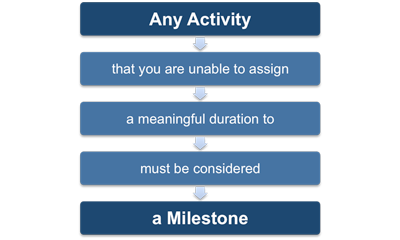 |
In the example above:
'Step 3 - Send Invitations to Tender' and
'Step 9 - Appoint Contractor'
would be considered a milestone rather than an activity .
The technique of decomposition, as applied to defining activities, involves subdividing the project work packages into smaller, more manageable components called activities. Activities represent the effort needed to complete a work package.
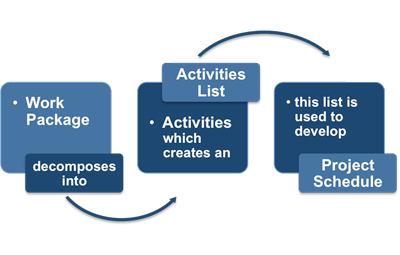 |
The activity list, work breakdown structure, and WBS dictionary can be developed either sequentially or concurrently, with the WBS and WBS dictionary as the basis for development of the final activity list. Each work package within the WBS is decomposed into the activities required to produce the work package deliverables. Involving team members in the decomposition can lead to better and more accurate results.
This decomposition will usually be carried out as part of a planning workshop involving as much expertise as necessary to ensure that the activities are accurately identified and it should be of sufficient detail to create a realistic and feasible schedule. This list would also have extra information about each activity such as constraints, assumptions, logical relationships, etc.
As well as decomposing the WBS work packages, there is another technique that can help with defining the activities. Rolling wave planning (RWP) is the process of project planning in waves as the project proceeds and later details become clearer. It involves progressive elaboration and is based on the fact that activities required in the immediate future will be known in greater detail than those further into the future. This means that WBS components will exist in different level of detail in the structure.
Progressive elaboration means that the work packages are refined in greater detail over time. RWP is particularly useful in projects of high uncertainty like software development or R&D projects, where the project goal is known, but the final deliverable may change somewhat as the project progresses.
 |
Attempting to create detailed task-oriented plans for project teams in these types of environments is likely to lead to plans that are abandoned soon after being published and a great deal of project management time spent endlessly re-planning rather than actually managing the project.
Rolling wave planning is more often used within IT type projects but less so within the construction industry where lack of detail in initial plans may cause huge expense later. Unfortunately many IT projects undertake the bulk of their planning too early in the lifecycle, when little concrete data is known about the problem domain, business environment, or how the team will work together.
The activity list is a comprehensive list including all schedule activities required by the project. The activity list includes the activity identifier and a scope of work description for each activity in sufficient detail to ensure the project team members understand what work is required to be completed.
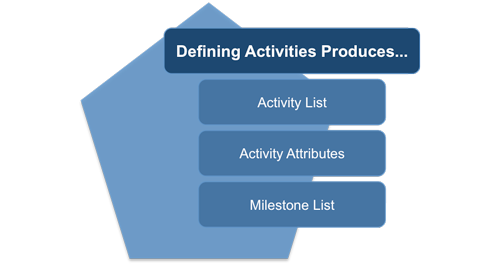 |
Activity attributes extend the description of the activity by identifying the components associated with each one. The components for each activity evolve over time. Activity attributes can be used to identify the person responsible for executing the work, where the work will be performed and the activity type. They are used for schedule development and for selecting, ordering and sorting the planned scheduled activities in various ways within reports.
A milestone is a significant point or event in the project. A milestone list identifies all milestones and indicates whether it is mandatory such as those required by contract or optional.
You may also be interested in:
Managing the Project Schedule | Defining the Project Activities | Sequencing the Project Activities | Estimating the Resources Required | Estimating the Time Required | Developing the Project Schedule | Controlling the Project Schedule.
|
|


